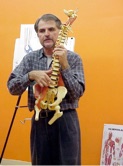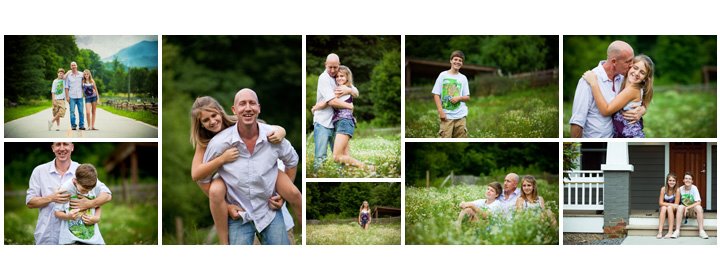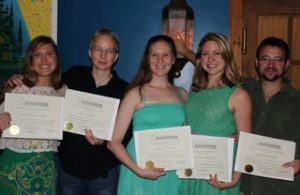On the Leading EDGE of Myo*-Structural Balancing & Mindful Medical Massage …
Kyle C. Wright, LMBT
Master Bodyworker, Author, & Curriculum Developer
of the Schools of Advanced Bodywork
* The term MYO- means Muscle.
For us, and our Whole Health Viewpoints, the word MUSCLE includes the Muscle Cells and their Fascial Sheaths/Tendons, and the Nerves controlling them. AND there is a MIND operating behind the scenes as well.
We at the Wright Center address them ALL as a fully functional, integrated system.
Some people ask if we do “Fascial Work”?
For us, the Muscle Cells & Fascial Sheaths (which also ARE the tendons) operate in VERY close, inter-dependent harmony with each other. We do NOT treat them as separate systems, preferring a more wholistic, integrated approach to therapy.
With more than 90,000 Patient Visits, and FORTY+ YEARS of Experience,
Kyle’s Results and Happy Clients speak for themselves.
“I’ve been assisting with management and bookings for Kyle at his Wright Center for several months now. THE thing I hear MOST Clients say about Kyle is:
‘NO ONE does what Kyle does.’
And he gets RESULTS like no one else.”
~David Scott Lynn
Founder of DSL Edgework & Myo-Structural Balancing
Practicing clinical and structural forms of bodywork for over 40 years. I, Kyle Wright, and my Schools of Advanced Bodywork have trained over 12,000 students.
And I’ve treated approximately 100,000 people for chronic pain issues.
Over 3 decades, I’ve had the privilege of being part of one of the fastest-growing professions in health care: massage therapy. In 1992 I started my first clinical massage therapy school, which eventually evolved into five schools throughout the Southeast.
 The well-planned curriculum enabled students to graduate with the skills making them highly employable and able to meet the growing demand for clinically trained massage therapists.
The well-planned curriculum enabled students to graduate with the skills making them highly employable and able to meet the growing demand for clinically trained massage therapists.
In the years since starting that first school, I’ve had the good fortune and freedom to experiment with new approaches to soft-tissue therapy. And now, the innovative techniques my previously owned schools have been teaching since 1992 are becoming more widely accepted by mainstream massage educators and practitioners.
During that time, I was the Founder, Chief Executive Officer, and curriculum developer of five Southeastern Schools of Neuromuscular & Massage Therapy located in Florida, North Carolina, and South Carolina, which I owned and operated successfully with my partners for 17 years.
After those years of developing and managing a large administrative and teaching staff, I decided to get back to basics and a higher quality of life. In 2007, I sold the schools to Keiser University and moved just outside of Asheville, to the quaint town of Fairview, North Carolina.
Eventually, I opened a new school in Fairview, the North Carolina School of Advanced Bodywork (NCSAB).
After 5 years in the beautiful mountains of Asheville, NC, NCSAB has moved to a larger market: Charlotte, NC. We are very excited to be able to offer our Clinical & Structural Bodywork Program where we can ensure it continues to grow in the bodywork community. Not only does NCSAB offer a program meeting the needs for licensure, but takes the student much further into the specific treatment of soft tissue pain due to muscular imbalances, injury, or postural distortion.
Then, a few years later, I opened a new School of Advanced Bodywork (FLSAB) in Jacksonville, Florida, where my very first school opened in 1992.
What is Clinical Massage Therapy?
A Special Message from Kyle C. Wright, LMBT, NCTMB:
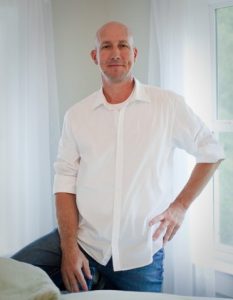 Clinical Massage Therapy, one of more than 80 different types of massages, uses manual touch to manipulate soft tissues throughout the human body. Patients seek massage therapists for a number of reasons, including decompressing tired muscles, reducing stress, and supporting general health.
Clinical Massage Therapy, one of more than 80 different types of massages, uses manual touch to manipulate soft tissues throughout the human body. Patients seek massage therapists for a number of reasons, including decompressing tired muscles, reducing stress, and supporting general health.
Clinical massage therapy uniquely focuses on the treatment of soft tissue to maintain, develop, augment, or rehabilitate the patient’s physical function. Clinical massage therapy can improve the functioning of joints and muscles, the healing process, metabolism, and circulation.
For over two decades, I’ve had the privilege of being a part of one of the fastest-growing professions in health care: massage therapy. In 1990 I started my first clinical massage therapy school, which eventually evolved into five schools throughout the southeast. The well-planned curriculum enabled students to graduate with the skills that would make them employable and able to meet the growing demand for clinically trained massage therapists. When when I graduated from massage therapy school and started my first class with six quality dedicated students, I never imagined witnessing over 8,000 students graduate with the same level of determination I had.
Bringing New Innovations To The Massage Profession
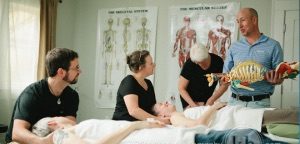 In the years since starting that first school, I have had the good fortune and freedom to experiment with new and innovative approaches to soft-tissue therapy. It is not always easy—and often even risky—to be an early adapter of new ideas and techniques. This is especially true when the ideas go against the common understandings and practices of the day. At the time, these common practices included much of what I had previously been taught by leaders in the field. Yet, the techniques my own schools have been teaching for nearly 20 years are steadily working their way into acceptance by mainstream massage educators and practitioners.
In the years since starting that first school, I have had the good fortune and freedom to experiment with new and innovative approaches to soft-tissue therapy. It is not always easy—and often even risky—to be an early adapter of new ideas and techniques. This is especially true when the ideas go against the common understandings and practices of the day. At the time, these common practices included much of what I had previously been taught by leaders in the field. Yet, the techniques my own schools have been teaching for nearly 20 years are steadily working their way into acceptance by mainstream massage educators and practitioners.
I firmly believe my new North Carolina School of Advanced Bodywork, and the new sister school, the Florida School of Advanced Bodywork, will bridge the best of traditional massage and bodywork with cutting-edge clinical therapy techniques and practices.
David Scott Lynn (DSL EdgeWork: Yoga – Bodywork Therapeutics) contributed and collaborated with me in the writing, research, and development of my textbook on Structural Balancing, as well as teaching me his philosophy and sharing his effective psycho-muscular balancing techniques. In the mid-1990s, David taught me how to reach deeper levels into the body without producing pain in the client.
The main things I learned from David were about playing the physical and mental “Edges” and his theory on Chronic Excess Muscle & Nerve Tension & Stress (C.E.M.&N.T.). After incorporating his yoga and bodywork techniques in my practice and schools, I can say without reservation that his theories on muscular compensatory adaptation allowed me to take my bodywork to the next level.
Clinical / Medical Massage Therapy & Myo-Structural Bodywork is a compilation reflecting my years of education, practice and instruction in the field of clinical massage therapy. It is a product of the beliefs I share with so many others. One such belief is that students are entitled to superior education and individualized training so they may uphold, or excel beyond, the professional standards they continually pursue.
The North Carolina SAB and Florida SAB texts and curriculum are forward-thinking and express my philosophy and interpretations of the neuromuscular and skeletal systems and their relation to the body’s structure and function. The text and graphics used at FloridaSAB are sequenced so the fundamentals are set as the basis upon which more advanced techniques are built.
Rather than attempt to encompass a wide range of massage techniques, our program focuses more deeply on certain aspects, such as Clinical / Medical Massage Therapy and Myo-Structural Bodywork, and less on others. I came to write the curriculum material and school syllabus to assist the student’s educational development in learning and understanding a higher-level approach to massage therapy and bodywork.
Throughout my career I built a strong following and reputation for being a goal and results-oriented bodyworker, working on people that suffered from musculoskeletal pain.
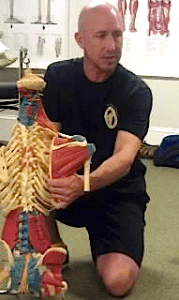 My approach to teaching bodywork has been addressing and eliminating postural distortions caused by muscular tension and muscular imbalances. It is my experience that many of the painful afflictions people suffer from are caused by the gravitational force that’s being continually applied to their body and the way their body painfully opposes it.
My approach to teaching bodywork has been addressing and eliminating postural distortions caused by muscular tension and muscular imbalances. It is my experience that many of the painful afflictions people suffer from are caused by the gravitational force that’s being continually applied to their body and the way their body painfully opposes it.
Most often (and rarely mentioned in modern medical practices) is the lack of understanding of how postural distortions have direct and negative effects on the body. These negative effects are often from the body being pulled down and forward by gravity, literally compressing the body cell by cell, molecule by molecule. On top of that, most people are not even aware that poor posture eventually leads to musculoskeletal pathology.
Through practice, I’ve evaluated and treated thousands of people suffering from chronic pain. Most of the time, musculoskeletal pain is caused by the way the body opposes gravity inefficiently, meaning, their body weight has shifted off the bones and onto the muscles. This body shifting, altering, and compensation often leads to a constant barrage of trigger point formation, referral of pain to distant areas, deviations (unevenness) in leg lengths, distortions in the pelvis and spine (misalignments), depressed or elevated shoulder girdles, as well as causing a collapsed (stooped or slouched) upper body and forward head positioning.
My objective in sharing this approach is for students to start focusing on muscles overly “locked” short from Chronic Excess Muscle & Nerve Tension & Stress (C.E.M.&N.T.) and the muscular imbalances linking poor posture, musculoskeletal pain, and restriction of body movements.
The goal of the Florida and North Carolina SAB Curriculums are to prepare you, the student, so when you have a person on your table with complaints of muscle pain and/ or restriction you’ll have a clearer picture and a deeper level of understanding of what is below the skin surface, what you’re working on, and what muscles could be causing it.
The premise of this bodywork is to create symmetry among muscle groups by applying effective and consciously applied massage therapy techniques and stretches to the shortened muscles, not necessarily the painful ones. This can be achieved by learning and practicing deep-tissue work, the non-painful kind that isolates the cause of the problem rather than just massaging the area of complaint.
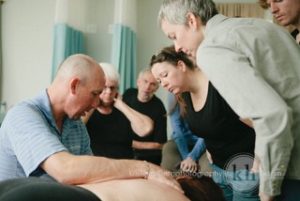 While learning at FloridaSAB, I strongly encourage the use of repetition while learning hand placements. Repetition is extremely beneficial for students; as lessons are repeated, they become imprinted on the memory. During classroom “trades,” students build confidence with each practice session. We encourage students to give continuous feedback during trades between giver and receiver, whether it is in the form of praise, constructive criticism, or both. Feedback further allows for academic and spiritual growth while perfecting hands-on delivery skills.
While learning at FloridaSAB, I strongly encourage the use of repetition while learning hand placements. Repetition is extremely beneficial for students; as lessons are repeated, they become imprinted on the memory. During classroom “trades,” students build confidence with each practice session. We encourage students to give continuous feedback during trades between giver and receiver, whether it is in the form of praise, constructive criticism, or both. Feedback further allows for academic and spiritual growth while perfecting hands-on delivery skills.
I encourage students to explore the art and science of clinical massage therapy and structural bodywork and everything it has to offer, as well as to expand their study and practice of massage therapy in general. The focus should not be on so-called “alternative methods,” but on adjunctive methods.
Additionally, I recognize that massage therapy can be extremely effective either by itself or as an adjunct to other interventions, such as flexibility and strength training exercises, chiropractic, and acupuncture, as well as emotional and spiritual healing.
The FloridaSAB teaching staff has 30 years of experience in the massage and bodywork profession both in practice and instruction. It is with great pleasure we share our massage and bodywork experience, knowledge, and practical skills with you. I commend both instructors and students for choosing this course of study and profession.
I sincerely hope that together we may continue to enlighten the world about the value of massage therapy and how it fits into our healthcare system today and into the future.
Thank You For Visiting Our Website and Reading About the FSAB,
Kyle C. Wright, LMBT, NCTMB
One-On-One with KYLE C. WRIGHT
Kyle C. Wright, LMBT, NCTMB, offers 1, 2 & 3-hour private bodywork sessions for those seeking pain relief. Kyle’s approach to massage and bodywork is to eliminate muscular imbalances and postural distortions often causing chronic musculoskeletal pain and joint restrictions.
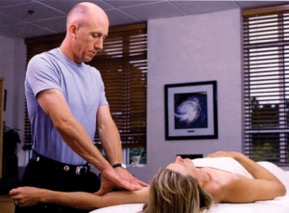 Deviations in leg lengths, distortions in the pelvis, functional scoliosis, and disc-related problems all have a soft tissue component addressed within each bodywork session. Plantar fasciitis, knee, hip, back, and neck pain as well as rotator cuff injuries usually stem from muscular imbalances caused by one group, or groups, of muscles “locking short” while the opposing muscles are “locking long.” If this muscular imbalance is left untreated, it often leads to chronic pain. Injuries very often from repetitive motion, muscular overload, and poor posture. Kyle specializes in postural/structural bodywork and pain relief.
Deviations in leg lengths, distortions in the pelvis, functional scoliosis, and disc-related problems all have a soft tissue component addressed within each bodywork session. Plantar fasciitis, knee, hip, back, and neck pain as well as rotator cuff injuries usually stem from muscular imbalances caused by one group, or groups, of muscles “locking short” while the opposing muscles are “locking long.” If this muscular imbalance is left untreated, it often leads to chronic pain. Injuries very often from repetitive motion, muscular overload, and poor posture. Kyle specializes in postural/structural bodywork and pain relief.
To look further into your situation and what might be causing your pain and schedule an appointment with him and his staff, give Kyle a call. Kyle takes one session at a time and is a goal-oriented bodywork therapist that gets results. (See Testimonials.)
FEES:
As of January 1st, 2024
New Patient
2 Hours $250
Returning Patients
1 Hour $150
1.5 Hours $200
2 Hours $250
2.5 Hours $300
3 Hours $350
CLICK HERE to BOOK NOW at Our
ONLINE Appointment Scheduler
Office hours are Monday through Thursday from 9 AM to 5:30 PM. You may contact Kyle at:
(828) 628-3007

